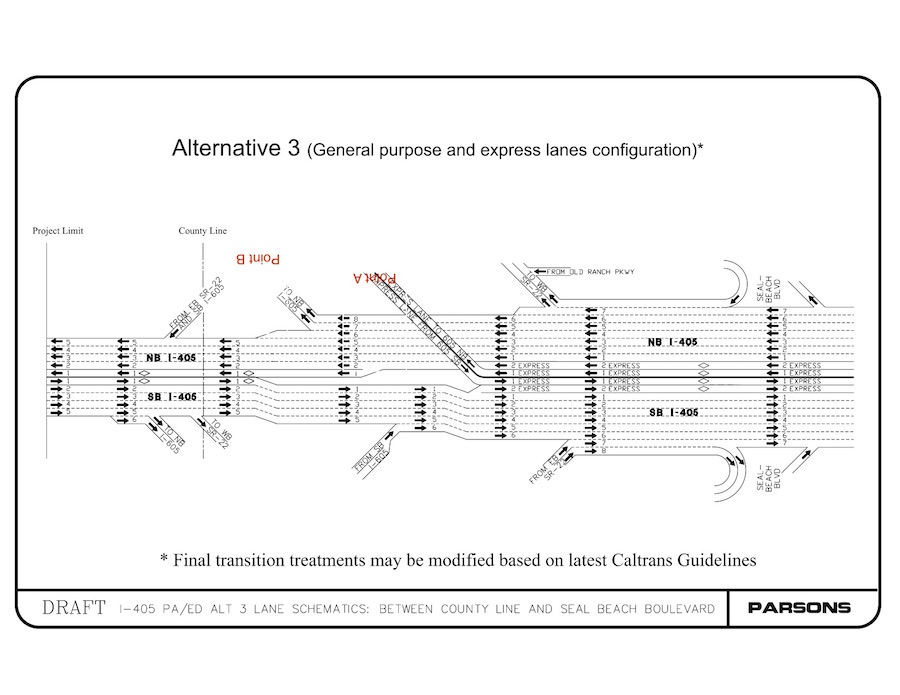
A map of the improvement project affected areas from the OCTA website.
The City of Long Beach could be headed toward a showdown with CalTrans and the Orange County Transportation Authority (OCTA), as it agreed last week to move forward with a lawsuit against the two entities over plans to expand the 405 Freeway.
In a closed session meeting last week, the Long Beach City Council granted the city attorney permission to file a suit against the OCTA and CalTrans, citing unmitigated costs to the city in terms of increased traffic from the proposed I-405 Freeway Improvement Project, which is set to begin construction next year.
The project would expand the freeway by four lanes and include an express lane stretching from Costa Mesa to where the 405 intersects the 22 freeway. The express lanes would operate much like the ones already existing on the 91 and 110 Freeways, but whether or not a transponder would be required or how high the fares would be has yet to be determined.
In a tweet last week, Mayor Robert Garcia described the terms of the plans as “unacceptable” because of what he called significant impacts on the City of Long Beach. He vowed that the city would fight the project in court.
Assistant City Attorney Michael Mais said that because of the construction that would occur east of Long Beach and then cease at the border, it would create a bottleneck-effect at the 605 interchange resulting in a “traffic nightmare.”
The proposed plans would expand the freeway between Long Beach and Costa Mesa to about 16 lanes, but then reduce down to about 10 lanes at the the 605. The city’s lawsuit is seeking mitigation measures from the parties to help it better deal with the influx of traffic that it is expected to incur on surface streets. Mais projected it would involve about a 39 percent increase, once the project is completed.
“We really want them to consider the impact of this project in Long Beach and consider it seriously, take a look at it, take an effective traffic study of what this will actually cause on our side of the border,” Mais said. “And once they make that assessment, take steps to spend money to do what needs to be done in our city to handle the traffic.”
Among other things, Mais said the city wants OCTA and CalTrans to perform a separate traffic study to give a more clear picture of how the freeway expansion would affect the city. He added that this study would give a better picture of what sum of money the city would be seeking in compensation to better outfit arterial roads like Bellflower Boulevard, Seventh Street, Pacific Coast Highway and possibly Studebaker Road, as they are all projected to be impacted by the project.
“Even though their [OCTA] jurisdictional boundary ends that doesn’t mean the affects of the project end because they have drawn an artificial border,” Mais said. “ We want to hear from them what they’re willing to do. We want them to do an appropriate study and that will help us generate a dollar figure for what it would cost to mitigate.”
The filing of the suit is the first step of possible litigation that will be preceded by a discussion about a possible settlement between the sides.

A preliminary draft of how lanes would merge between the 22 connector (left) and Seal Beach Boulevard (right). Photo: OCTA
A representative from CalTrans said they would not comment on pending litigation, but Joel Zlotnik, a media relations officer with the OTCA, said that a supplemental study was already performed in 2013 at the request of the City of Long Beach to address how it would affect the city.
The study, completed in June 2013, used a statewide formula included in the CalTrans Guide for traffic impact studies that takes into account existing traffic conditions and projected traffic impact to arrive at a “fair share” value that the project would pay to Long Beach for each of the affected intersections.
The supplemental study identified about eight intersections in the city that would be eligible for funds from either the OCTA or CalTrans to help mitigate the cost of necessary upgrades, with the aim of offsetting increased traffic.
The largest “fair share” percentage calculated in 2013 construction costs was 25.02 percent at the intersection of Seventh Street and West Campus Drive ($300,000) to be paid by CalTrans. The largest dollar figure calculated was $810,000 (10.41 percent) to improve the Willow Street and Bellflower Boulevard intersection.
Zlotnik said that although the calculations are complex, the basic breakdown of the formula would be that the anticipated percentage share of mitigation would equal the percent of extra traffic attributed to the project. So, if the expansion project is expected to increase traffic by 10 percent, the project would be liable for 10 percent of the improvement to the arterial streets. Anything more, Zlotnik categorized as unfair.
“If there’s an intersection that’s currently severely congested and a project adds five percent more traffic to the intersection, should that project pay for 100 percent of improving the intersection?” Zlotnik asked. “Should the project pay for something that is already broken?”
He added that the OCTA had yet to receive the lawsuit from the city, so he could not comment on details of the suit and couldn’t comment on whether or not it would affect the timeline of the project.
Zlotlnik said that news of the suit being filed was “disappointing for the hundreds of thousands of people we’re trying to help throughout Southern California who are sitting in 405 traffic day after day.”

